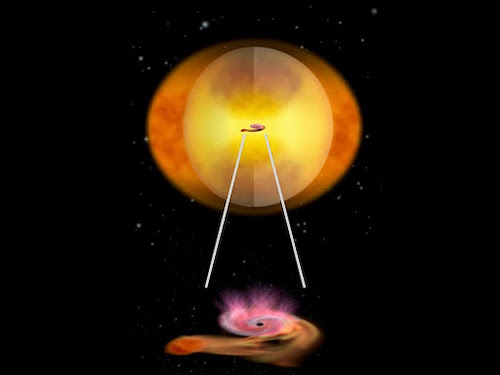Earth & Space
Students search for hidden black hole activity
When stars get too close to the supermassive black holes at the centers of galaxies, the black holes shred them apart in a process called a tidal disruption event (TDE). These TDEs cause bright flashes, but recent models suggest that scientists should see more of them than have been observed.

When stars get too close to the supermassive black holes at the centers of galaxies, the black holes shred them apart in a process called a tidal disruption event (TDE). These TDEs cause bright flashes, but recent models suggest that scientists should see more of them than have been observed.
One leading idea about the missing TDEs was that dust within some galaxies blocks the emission of visible light, obscuring certain TDEs from view. To investigate this possibility, a team of students at the University of California, Santa Cruz looked to the infrared, where the dust reemits most of the original light signal. In a paper recently published in the Astrophysical Journal Letters, they determine that scientists are not likely missing tidal disruption events because of dust — sending those searching for missing TDEs back to the drawing board.
The researchers studied the properties of 103 nearby galaxies that exhibit mid-infrared outbursts using a catalog based off of the Sloan Digital Sky Survey. They compared these galaxies to known tidal disruption events and active galactic nuclei — the bright centers of galaxies that emit light as the central supermassive black hole gulps down nearby gas
To their surprise, the researchers found that many of the mid-infrared outbursts they studied were likely not caused by tidal disruption events and instead looked more like highly variable active galactic nuclei.
The team, led by UC Santa Cruz Astronomy and Astrophysics PhD student Sierra Dodd, analyzed star formation rate and total stellar mass in the galaxies, as well as the dust properties of the nearby galaxies.
“I didn’t go in with strong expectations,” said Dodd. But one finding in particular surprised her.
Previous assumptions held that the amount of dust in the center of a galaxy correlates to the amount of dust in the galaxy as a whole.
“People were saying these certain highly-star forming galaxies that have more dust in them at large will probably have more dust in the nucleus, and therefore we’d be missing a bunch of tidal disruptions,” said Dodd. “So when we analyzed the dust mass in the center versus the galaxy for the 103 mid-infrared outbursts that we had and found that they weren’t correlated, that was very surprising to me.”
The implication that most of the mid-infrared outbursts are not hidden black holes tearing stars apart brings astrophysicists back to searching for an explanation for missing TDEs.
“Now that we found out that that’s probably not the case, it means that we’re still missing a population of these tidal disruption events or the models are missing something,” said Dodd.
She says the discovery of more mid-infrared outbursts and tidal disruption events will help researchers uncover where the missing TDEs are and what is causing some of the non-TDE outbursts.
“Doing some simulations of tidal disruption events and seeing what it might look like to have one enshrouded in dust would be useful as well,” she said.
The Lamat Institute gets students involved
For the project, Dodd mentored two students in the Lamat Institute at UC Santa Cruz.
Arya Nukala learned to use the galaxy catalog and contributed to analysis as a high school student, and Isabelle Connor worked on graphing and data analysis as a second-year undergraduate student at UC Santa Cruz.
“Lamat is this incredible research program that focuses on giving opportunities in STEM to underrepresented groups of people. They focus a lot on not having to leave your identity at the door when you go into a space of academia, which is amazing,” said Connor. “It was my first experience, and to be able to do that in my first year of college was just extremely transformative and opened so many doors for me.”
She adds that the Lamat Institute made the transition from competitive Olympic-level gymnastics to academia much easier for her. She plans to stay involved in the Lamat Institute and expand on her black hole research.
“I think overall it’s really cool how even just in this specific area of study of black holes, there’s still so much that people have yet to do research on,” Connor said. “It makes whatever you find very exciting because you are one of the first people to test and question assumptions that have been made with actual data… TDEs do seem to be quite unique events that happen in a very specific area, and I hope we can learn more about how we can find this unaccounted-for population.”